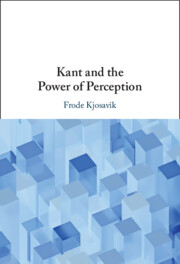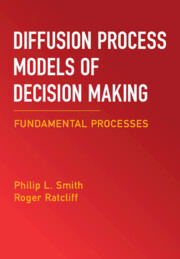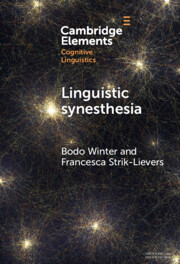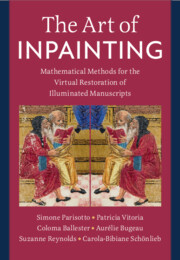Refine search
Actions for selected content:
393 results
Chapter 5 - Ideas
- from Part I - Method, Metaphysics, and Epistemology
-
- Book:
- The Philosophy of Antoine Arnauld
- Published online:
- 27 November 2025
- Print publication:
- 11 December 2025, pp 91-117
-
- Chapter
- Export citation

Kant and the Power of Perception
-
- Published online:
- 27 November 2025
- Print publication:
- 11 December 2025
Emergency Medical Services Perception of the Use of Wearables in Patient Management During Mass Casualty Incident Management
-
- Journal:
- Disaster Medicine and Public Health Preparedness / Volume 19 / 2025
- Published online by Cambridge University Press:
- 24 November 2025, e325
-
- Article
-
- You have access
- Open access
- HTML
- Export citation
The Argument from Imagination
-
- Journal:
- Journal of the American Philosophical Association , First View
- Published online by Cambridge University Press:
- 11 November 2025, pp. 1-19
-
- Article
-
- You have access
- Open access
- HTML
- Export citation
Perceived legitimacy as a third dimension of bicameralism: Czech senators versus the Czech general public
-
- Journal:
- European Political Science Review , First View
- Published online by Cambridge University Press:
- 27 October 2025, pp. 1-18
-
- Article
-
- You have access
- Open access
- HTML
- Export citation

Diffusion Process Models of Decision Making
- Fundamental Processes
-
- Published online:
- 26 October 2025
- Print publication:
- 13 November 2025

The Indispensability of Intuitions
-
- Published online:
- 21 October 2025
- Print publication:
- 13 November 2025
-
- Element
- Export citation
“Core Perception”: Re-imagining Precocious Reasoning as Sophisticated Perceiving
-
- Journal:
- Behavioral and Brain Sciences / Accepted manuscript
- Published online by Cambridge University Press:
- 06 October 2025, pp. 1-75
-
- Article
-
- You have access
- Export citation
Conclusions
-
- Book:
- Galen on Human Physiology
- Published online:
- 28 July 2025
- Print publication:
- 02 October 2025, pp 214-217
-
- Chapter
- Export citation
Chapter 19 - Affective Biases in Attention, Cognitive Control, and Awareness
- from Section V - Cognition–Emotion Interactions
-
-
- Book:
- The Cambridge Handbook of Human Affective Neuroscience
- Published online:
- 16 September 2025
- Print publication:
- 02 October 2025, pp 385-407
-
- Chapter
- Export citation
I’m whispering a white Christmas: masking relations in hallucinatory speech
-
- Journal:
- Language and Cognition / Volume 17 / 2025
- Published online by Cambridge University Press:
- 12 September 2025, e71
-
- Article
-
- You have access
- Open access
- HTML
- Export citation
Characteristics of a good training placement in psychiatry: qualitative interview study of core trainees
-
- Journal:
- BJPsych Open / Volume 11 / Issue 5 / September 2025
- Published online by Cambridge University Press:
- 18 August 2025, e184
-
- Article
-
- You have access
- Open access
- HTML
- Export citation
Chapter 15 - Boulez and Stockhausen
- from Part III - Engagements with the Post-War Generation of Composers
-
-
- Book:
- Boulez in Context
- Published online:
- 08 July 2025
- Print publication:
- 24 July 2025, pp 152-163
-
- Chapter
- Export citation
Numéro spécial sur la normativité : introduction
-
- Journal:
- Dialogue: Canadian Philosophical Review / Revue canadienne de philosophie / Volume 64 / Issue 1 / April 2025
- Published online by Cambridge University Press:
- 07 July 2025, pp. 3-11
-
- Article
-
- You have access
- Open access
- HTML
- Export citation
Experiences of Absence that Get the World Right
-
- Journal:
- Episteme , First View
- Published online by Cambridge University Press:
- 24 June 2025, pp. 1-19
-
- Article
-
- You have access
- Open access
- HTML
- Export citation

Linguistic Synesthesia
- A Meta-analysis
-
- Published online:
- 11 June 2025
- Print publication:
- 03 July 2025
-
- Element
- Export citation

The Art of Inpainting
- Mathematical Methods for the Virtual Restoration of Illuminated Manuscripts
-
- Published online:
- 22 May 2025
- Print publication:
- 22 May 2025
Chapter 5 - The Passivity of Perception and the Impassive Soul
-
- Book:
- Aristotle on the Nature and Causes of Perception
- Published online:
- 01 May 2025
- Print publication:
- 22 May 2025, pp 134-164
-
- Chapter
-
- You have access
- Open access
- HTML
- Export citation
Chapter 1 - Accounting for Receptivity
-
- Book:
- Aristotle on the Nature and Causes of Perception
- Published online:
- 01 May 2025
- Print publication:
- 22 May 2025, pp 24-43
-
- Chapter
-
- You have access
- Open access
- HTML
- Export citation
Chapter 4 - The Flesh and Bones of Perception
-
- Book:
- Aristotle on the Nature and Causes of Perception
- Published online:
- 01 May 2025
- Print publication:
- 22 May 2025, pp 100-133
-
- Chapter
-
- You have access
- Open access
- HTML
- Export citation
